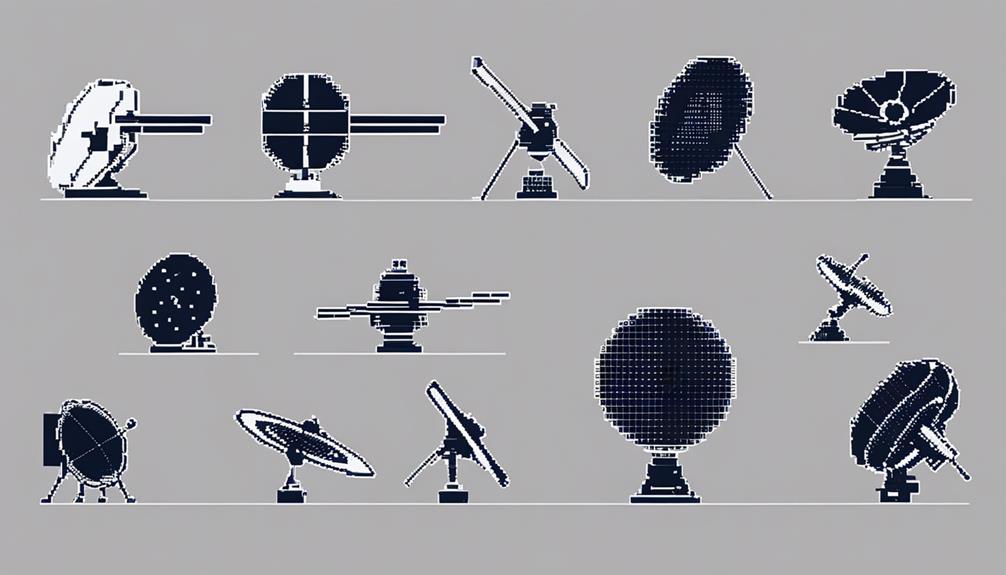Adaptive satellite antenna technologies stand at the forefront of enhancing communication systems' capabilities by offering dynamic solutions to address the challenges of today's interconnected world. From overcoming traditional limitations to harnessing the potential of phased-array and beamforming technologies, a new era of satellite antennas promises unprecedented advancements in signal quality and coverage. The intricate balance between adaptability and performance in these technologies opens the door to exploring the vast possibilities of optimized communication networks. As we navigate through the complexities of modern communication demands, the evolution of adaptive satellite antenna technologies continues to shape the future landscape of connectivity with innovation and precision.
Key Takeaways
- Beamforming technology enhances signal strength and coverage efficiency.
- Phased-array advancements enable precise signal directionality and dynamic beam steering.
- Miniaturized antennas support compact, high-performance satellite communication solutions.
- Adaptive antennas optimize data throughput, tracking capabilities, and power efficiency.
Limitations of Traditional Satellite Antennas

Traditional satellite antennas are characterized by fixed positioning and single-beam architecture, which significantly restrict their versatility and adaptability in satellite communications. These antennas lack the ability to dynamically adjust their beams to track moving satellites or targets on the ground, resulting in limited coverage and efficiency. Without beamforming technology, traditional antennas cannot focus signals in specific directions, leading to signal degradation and reduced communication reliability. This limitation becomes more pronounced in satellite systems requiring efficient communication over large areas or with multiple users simultaneously.
Moreover, the scalability constraints of traditional satellite antennas hinder their ability to support advanced features like multi-beam transmission and adaptive signal routing. The fixed nature of these antennas requires manual adjustments for repositioning, making them unsuitable for dynamic environments where constant monitoring and real-time adjustments are necessary for optimal performance. As a result, the potential for enhanced signal quality and network capacity is compromised, highlighting the need for advanced antenna technologies like phased array antennas in modern satellite systems.
Promise of Phased-Array Technology
Phased-array technology promises significant advancements in satellite antenna capabilities, particularly in beamforming for enhanced efficiency and dynamic beam steering. By enabling precise control over signal directionality, phased-array antennas optimize data throughput and coverage, ensuring robust communication links. These antennas represent a crucial innovation in aerospace, defense, and satellite communication industries due to their adaptive connectivity and reliable performance in challenging environments.
Beamforming for Efficiency
Implementing beamforming technology in satellite antennas revolutionizes signal optimization and coverage efficiency through dynamic signal adjustments. This technology, coupled with phased-array technology, offers numerous advantages in satellite communication systems:
- Enhanced Signal Quality: Beamforming techniques improve the signal quality and spatial sensitivity, ensuring better communication reliability.
- Improved Signal Strength: Beamforming in satellite antennas boosts signal strength, leading to clearer and more stable connections.
- Extended Coverage Range: Phased-array technology enables satellite antennas to cover larger geographical areas efficiently.
- Faster Data Transfer Rates: By utilizing beamforming, satellite antennas achieve faster data transfer rates, facilitating quicker information exchange.
Dynamic Beam Steering
Dynamic beam steering, a core feature of phased-array technology, revolutionizes signal optimization in satellite communication systems through precise electronic adjustments of beam directions for optimal signal reception. Phased-array technology enables antennas to dynamically adjust beam direction, offering improved signal quality and coverage for enhanced data transmission in satellite systems. By utilizing beamforming, phased-array antennas provide precise control over signal direction, enhancing communication reliability. The rapid beam scanning capabilities of phased-array antennas are crucial for tracking moving satellites and maintaining constant communication links. The adaptability of phased-array technology in steering beams ensures versatile and efficient communication solutions for satellite systems, making it a promising technology for the future of satellite data transmission.
Key Takeaways on Phased-Array Technology

A critical aspect of advanced satellite antenna technologies is the utilization of phased-array technology, which revolutionizes signal transmission and reception capabilities. Phased-array technology enables dynamic beam steering for enhanced signal strength and coverage, offering multi-beam transmission capabilities that optimize communication in diverse scenarios. These antennas are compact, reliable, and scalable, making them game-changers in aerospace, defense, and telecommunications industries. Advantages of phased-array technology include improved tracking, faster data transfer rates, and reduced power consumption.
Key Takeaways on Phased-Array Technology:
- Dynamic Beam Steering: Phased-array technology allows for dynamic beam steering, enhancing signal strength and coverage by directing beams where they are needed most.
- Multi-Beam Transmission: The capability for multi-beam transmission optimizes communication in various scenarios, ensuring efficient data transfer and reception.
- Compact and Scalable Design: Phased-array antennas are known for their compact, reliable, and scalable design, making them versatile for different applications.
- Industry Impact: With benefits spanning aerospace, defense, and telecommunications sectors, phased-array technology is a crucial component in modern communication infrastructure, improving overall performance and reliability.
Power of Beamforming Technology
Beamforming technology revolutionizes signal transmission in satellite antennas by precisely focusing radio signals to enhance reception quality and optimize communication efficiency. By dynamically adjusting the antenna's radiation pattern, beamforming enhances signal strength and reduces interference, allowing for more efficient communication capabilities. In satellite communication systems, beamforming enables the transmission of signals to specific users or satellites, improving data rates and extending coverage range.
The power of beamforming technology lies in its ability to adapt to changing signal conditions, thereby increasing data transfer rates and enhancing overall system performance. By utilizing beamforming techniques, satellite antennas can effectively communicate with multiple users simultaneously, ensuring reliable connections even in challenging environments. This technology plays a crucial role in improving the reliability and efficiency of satellite communication systems by focusing radio signals in desired directions and optimizing signal reception.
Future of Space Antennas With Beamforming

Future space antennas with beamforming technology offer enhanced signal strength, spatial sensitivity, and rapid data transfer rates. These advancements enable extended coverage range, improved tracking capabilities, and reduced power consumption for efficient operations. While beamforming presents significant benefits, the implementation challenges must also be carefully considered to ensure seamless integration into space communication systems.
Beamforming Benefits
By harnessing the power of advanced signal processing techniques, satellite antennas equipped with beamforming technology are poised to revolutionize the landscape of space communication systems. Beamforming in satellite antennas optimizes signal quality and range by electronically steering beams. It enhances signal strength, spatial sensitivity, and tracking capabilities in space communication. The benefits of beamforming technology include faster data transfer rates, extended coverage range, and multi-user access. Moreover, this technology ensures flexibility, adaptability, and reduced power consumption in satellite communication systems. Implementing beamforming in satellite antennas paves the way for improved performance, broader coverage, and enhanced efficiency in space communication networks.
Implementation Challenges
Challenges in the successful implementation of adaptive satellite antenna technologies, particularly those integrating beamforming capabilities, primarily revolve around optimizing power consumption and mitigating interference in space communication systems. Implementing beamforming in satellite antennas enhances signal quality and coverage, improving communication performance. Future space antennas with beamforming capabilities aim to adapt to changing communication needs and environmental conditions, enabling dynamic adjustments to optimize signal reception in various scenarios. Advanced algorithms and processing techniques are crucial in overcoming implementation challenges in satellite antennas with beamforming. These technologies play a significant role in enhancing the efficiency and reliability of satellite communication systems, paving the way for improved connectivity and data transmission in space.
Advancements in Miniaturized Antennas
Recent developments in miniaturized antenna technologies have revolutionized the field of satellite communications by offering compact yet high-performance solutions for space-constrained applications. These antennas leverage advanced materials and innovative design techniques to achieve remarkable performance in compact form factors, enabling a wide range of applications in satellite communication systems. The advancements in miniaturization technology have facilitated the seamless integration of antennas into various communication systems, enhancing their overall efficiency and effectiveness.
Advancements in Miniaturized Antennas:
- Reduced Size and Weight: Miniaturized antennas provide a significant reduction in size and weight compared to traditional antennas, making them ideal for space-constrained applications where every gram matters.
- Utilization of Advanced Materials: These antennas incorporate advanced materials that enable superior performance in terms of signal quality and reliability, ensuring high data throughput even in compact satellite platforms.
- Enhanced Portability and Flexibility: Miniaturized antennas contribute to enhancing the portability and flexibility of satellite communication systems, allowing for easier deployment and reconfiguration as needed.
- Critical Role in Data Throughput: Miniaturized antennas play a crucial role in enabling high data throughput and reliable connectivity, essential for meeting the increasing demands of modern satellite communication systems.
Importance of Miniaturized Antennas

Miniaturized antennas play a pivotal role in optimizing the efficiency and performance of satellite communication systems through their compact design and enhanced functionality. These antennas are essential for reducing the overall size and weight of satellite systems, enabling increased payload capacity and improved maneuverability in space missions. By supporting the trend towards smaller and more efficient satellite designs, miniaturized antennas contribute significantly to enhancing satellite performance while maintaining signal quality and coverage.
The importance of miniaturized antennas lies in their ability to advance satellite technology by providing compact designs that do not compromise signal quality. With the continuous demand for agile communication systems, these antennas have become crucial components in developing satellite systems that can swiftly adapt to changing communication needs. As technology advances, miniaturized antennas continue to play a vital role in ensuring that satellite systems remain competitive, efficient, and capable of meeting the growing demands of modern communication networks.
Frequently Asked Questions
What Is Adaptive Antenna System?
An adaptive antenna system is a technology that dynamically adjusts its radiation pattern to optimize signal quality and reception performance. By utilizing advanced algorithms and techniques such as beamforming, phased array, smart antennas, MIMO technology, signal processing, and antenna arrays, these systems can modify antenna characteristics in real-time based on changing environmental conditions and communication requirements. This adaptation ensures improved signal strength, reduced interference, and enhanced communication reliability.
What Are the 3 Basic Types of Antennas?
Antennas come in three basic types: dipole, monopole, and parabolic. Dipole antennas use two conductive elements, monopoles use one, and parabolic antennas employ dish reflectors to focus radio waves onto a receiver. Each type has its unique applications and advantages based on factors like directionality, gain, and directivity. Understanding these antenna varieties is crucial for designing effective communication systems tailored to specific requirements.
What Are the Types of Antenna Used in Satellite Communications?
In satellite communications, various types of antennas are utilized for signal transmission and reception. These include Parabolic reflectors for high gain, Phased arrays for beam steering, Helical antennas for circular polarization, Patch antennas for compactness, Horn antennas for wide bandwidth, and Yagi Uda antennas for directional radiation patterns. Each type offers unique advantages in optimizing signal performance for satellite communication systems.
What Is a SAT Antenna?
A satellite antenna, commonly referred to as a SAT antenna, is an essential component in satellite communication systems. It is designed to facilitate satellite reception, ensuring optimal signal strength and quality. These antennas are engineered to support beam steering, operate across various frequency bands, and accommodate different polarization types. Additionally, SAT antennas are crucial for maintaining tracking accuracy, enabling reliable communication between satellites and ground stations or user terminals.

